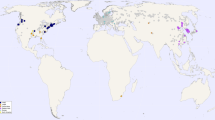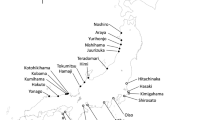Abstract
Phenakospermum guyannense is a monotypic, arborescent, long-lived monocot that is widespread in Amazonian South America. This outcrossing species is pollinated primarily by phyllostomid bats. Given these life-history characteristics,P. guyannense is expected to exhibit high levels of genetic variation and gene flow. We used isozyme electrophoresis and randomly amplified polymorphic DNA (RAPD) to characterize genetic variation in populations ofP. guyannense from French Guiana. Both measures detected a surprisingly low level of genetic variation, with only five out of twenty (25%) allozyme loci polymorphic (P), 1.35 alleles per locus (A), and an expected heterozygosity (He) of 0.090 at the species level. Isozymic genetic variation was even lower within populations (P = 17.5, A = 1.24, He = 0.074), and was corroborated by a RAPD assay that used 26 arbitrary primers (P = 3.61, A = 1.04, He = 0.014). Although overall levels of variation were low, the detectable variation was distributed as would be expected for an outcrossing species with extensive gene flow (mean GST = 0.230). We suspect thatP. guyannense is depauperate in genetic variation because of a series of bottlenecks that affected the species over this portion of its range.
Similar content being viewed by others
References
Aruna, M., Ozias-Akins, P., Austin, M.E., Kochert, G., 1993: Genetic relatedness among rabbiteye blueberry (Vaccinium ashei) cultivars determined by DNA amplification using single primers of arbitrary sequences. — Genome36: 971–977.
Barrett, S.C.H., Kohn, J. R., 1991: Genetic and evolutionary consequences of small population size in plants: implications for conservation. — InFalk, D.A., Holsinger, L.E., (Eds): Genetics and conservation of rare plants, pp. 3–30. — New York: Oxford University Press.
Bowditch, B.M., Albright, D.G., Williams, J.G.K., Braun, M.J., 1993: Use of randomly amplicified polymorphic DNA markers in comparative genome studies. — Meth. Enzymol.224: 294–309.
Brauner, S., Crawford, D.J., Stuessy, T.F., 1992: Ribosomal DNA and RAPD variation in the rare plant familyLactoridaceae. — Amer. J. Bot.79: 1436–1439.
Bult, C., Källersjö, M., Suh, Y., 1992: Amplification and sequencing of 16/18S rDNA from gel-purified total plant DNA. — Pl. Molec. Biol. Reporter10: 273–284.
Büscher, N., Zyprian, E., Blaich, R., 1993: Identification of grapevine cultivars by DNA analyses: pitfalls of random amplified polymorphic DNA techniques using 10mer primers. — Vitis32: 187–188.
Cardy, B.J., Stuber, C.W., Goodman, M.M., 1980: Techniques for starch gel electrophoresis of enzymes from maize (Zea mays L.). — Inst. Stat. Mimeo. 1317. — Raleigh: North Carolina State University.
Carlson, J.E., Tulsieram, L.K., Glaubitz, J.C., Luk, V.W.K., Kauffeldt, C., Rutledge, R., 1991: Segregation of random amplified DNA markers in F1 progeny of conifers. — Theor. Appl. Genet.83: 194–200.
Chalmers, K.L., Waugh, R., Sprent, J.I., Simons, A.J., Powell, W., 1992: Detection of genetic variation between and within populations ofGliricidia sepium andG. maculata using RAPD markers. — Heredity69: 465–472.
Echt, C.S., Erdhal, L.A., McCoy, T.J., 1991: Genetic segregation of random amplified polymorphic DNA in diploid cultivated alfalfa. — Genome35: 84–87.
Ellsworth, D.L., Rittenhouse, K.D., Honeycutt, R.L., 1993: Artifactual variation in randomly amplified polymorphic DNA banding patterns. — BioTechniques14: 214–217.
Fleming, T.H., 1982: Foraging strategies of plant-visiting bats. — InKunz, T.H., (Ed.): Ecology of bats, pp. 287–325. — New York: Plenum.
Fukuoka, S., Hosaka, K., Kamijima, O., 1992: Use of random amplified polymorphic DNAs (RAPDs) for identification of rice accessions. — Japan. J. Genet.67: 243–252.
Giles, B.E., 1984: A comparison between quantitative and biochemical variation in the wild barleyHordeum murinum. — Evolution38: 34–41.
Gottlieb, L.D., 1981: Electrophoretic evidence and plant populations. — Progr. Phytochem.7: 1–46.
Hamrick, J.L., Godt, M.J.W., 1989: Allozyme diversity in plant species. — InBrown, A.H.D., Clegg, M.T., Kahler, A.L., Weir, B.S., (Eds): Plant population genetics, breeding, and genetic resources, pp. 43–63. — Massachusetts: Sinauer.
Hu, J., Quiros, C.F., 1991: Identification of broccoli and cauliflower cultivars with RAPD markers. — Pl. Cell Rep.19: 505–511.
Kazan, K., Manners, J.M., Cameron, D.F., 1993: Genetic relationships and variation in theStylosanthes guianensis species complex assessed by random amplified polymorphic DNA. — Genome36: 43–49.
Kress, W.J., 1990: The phylogeny and classification of theZingiberales. — Ann. Missouri Bot. Gard.77: 698–721.
—, 1994: Flowering plant reproductive systems. — InMcDade, L.A., Bawa, K.S., Hespenheide, H.A., Hartshorn, G.S., (Eds): La Selva: ecology and natural history of a Neotropical rain forest, pp. 161–182. — Chicago: University of Chicago Press.
—, 1993: Morphology and floral biology ofPhenakospermum (Strelitziaceae), an arborescent herb of the Neotropics. — Biotropica25: 290–300.
Levi, A., Rowland, L.J., Hartung, J.S., 1993: Production of reliable randomly amplified polymorphic DNA (RAPD) markers from DNA of woody plants. — Hort. Sci.28: 1188–1190.
Lewis, P.O., 1992: GeneStat-PC, ver. 3.3. — Raleigh: North Carolina State University.
Liu, Z., Furnier, G.R., 1993: Comparison of allozyme, RFLP, and RAPD markers for revealing genetic variation within and between trembling aspen and bigtooth aspen. — Theor. Appl. Genet.87: 97–105.
Loveless, M. D., Hamrick, J. L., 1984: Ecological determinants of genetic structure in plant populations. — Annu. Rev. Ecol. Syst.15: 65–95.
Manchester, S.R., Kress, W.J., 1993: Fossil bananas (Musaceae):Ensete oregonense from the Eocene of western North America and its phytogeographic significance. — Amer. J. Bot.80: 1264–1272.
Marshall, D.R., Brown, A.H.D., 1975: The charge-state model of protein polymorphism in natural populations. — J. Molec. Evol.6: 149–163.
McLellan, T., Inouye, L.S., 1986: The sensitivity of isoelectric focusing and electrophoresis in the detection of sequence differences in proteins. — Biochem. Genet.24: 571–577.
Morden, C.W., Doebley, J., Schertz, K.F., 1987: A manual of techniques for starch gel electrophoresis ofSorghum isozymes. — The Texas Agricultural Exp. Station MP-1635. — College Station: Texas A & M University.
Mossler, A., Egger, K.N., Hughes, G.A., 1992: Low levels of genetic diversity in red pine confirmed by random amplified polymorphic DNA markers. — Canad. J. Res.22: 1332–1337.
Nei, M., 1978: Estimation of average heterozygosity and genetic distance from a small number of individuals. — Genetics89: 583–590.
Prance, G.T., 1989: American tropical forests. — InLieth, H., Werger, M.J.A., (Eds): Tropical rain forest ecosystems. Ecosystems of the world,14B, pp. 99–132. — Amsterdam: Elsevier.
Rafalaski, J.A., Tingey, S.V., Williams, J.G.K., 1991: RAPD markers — a new technology for genetic mapping and plant breeding. — Agbiotech. News Inform.3: 645–648.
Servant, M., Maley, J., Turcq, B., Absy, M.-L., Brenac, P., Fournier, M., Ledru, M.-P., 1993: Tropical forest changes during the Late Quartenary in African and South American lowlands. — Global Planetary Change7: 25–40.
Slatkin, M., Barton, N.H., 1989: A comparison of three indirect methods for estimating average levels of gene flow. — Evolution43: 1349–1368.
Soltis, D.E., Haufler, C.H., Darrow, D.C., Gastony, G.J., 1983: Starch gel electrophoresis of ferns: a compilation of grinding buffers, gel and electrode buffers, and staining schedules. — Amer. Fern J.73: 9–27.
Stiles, J.I., Lemme, C., Sondur, S., Morshidi, M.B., Manshardt, R., 1993: Using randomly amplified polymorphic DNA for evaluating genetic relationships among papaya cultivars. — Theor. Appl. Genet.85: 697–701.
Swofford, D.L., Selander, R.B., 1989: BIOSYS-1: a computer program for the analysis of allelic variation in population genetics and biochemical systematics. Release 1.7. — Champaign, Ill.: Illinois Natural History Survey.
Tomlinson, P.B., 1960: The anatomy ofPhenakospermum (Musaceae). — J. Arnold Arbor.41: 287–297.
Van Heusden, A.W., Bachmann, K., 1992: Genetic differentiation ofMicroseris pygmaea (Asteraceae, Lactuceae) studied with DNA amplification from arbitrary primers (RAPDs). — Acta Bot. Neerl.41: 385–395.
Wilde, J., Waugh, R., Powell, W., 1992: Genetic fingerprinting ofTheobroma clones using randomly amplified polymorphic DNA markers. — Theor. Appl. Genet.83: 871–877.
Williams, J.G.K., Kubelik, A.R., Rafalaski, J.A., Tingey, S.V., 1990: DNA polymorphisms amplified by arbitrary primers are useful as genetic markers. — Nucleic Acids Res.18: 6531–6535.
—, 1991: Genetic analysis with RAPD markers. — InBennet, J.W., Lasure, L.L., (Eds): More gene manipulations in fungi, pp. 431–439. — San Diego: Academic Press.
—, 1993: Genetic analysis using random amplified polymorphic DNA markers. — Meth. Enzymol.218: 704–740.
Author information
Authors and Affiliations
Rights and permissions
About this article
Cite this article
Roesel, C.S., Kress, W.J. & Bowditch, B.M. Low levels of genetic variation inPhenakospermum guyannense (Strelitziaceae), a widespread bat-pollinated Amazonian herb. Pl Syst Evol 199, 1–15 (1996). https://doi.org/10.1007/BF00985914
Received:
Revised:
Accepted:
Issue Date:
DOI: https://doi.org/10.1007/BF00985914




